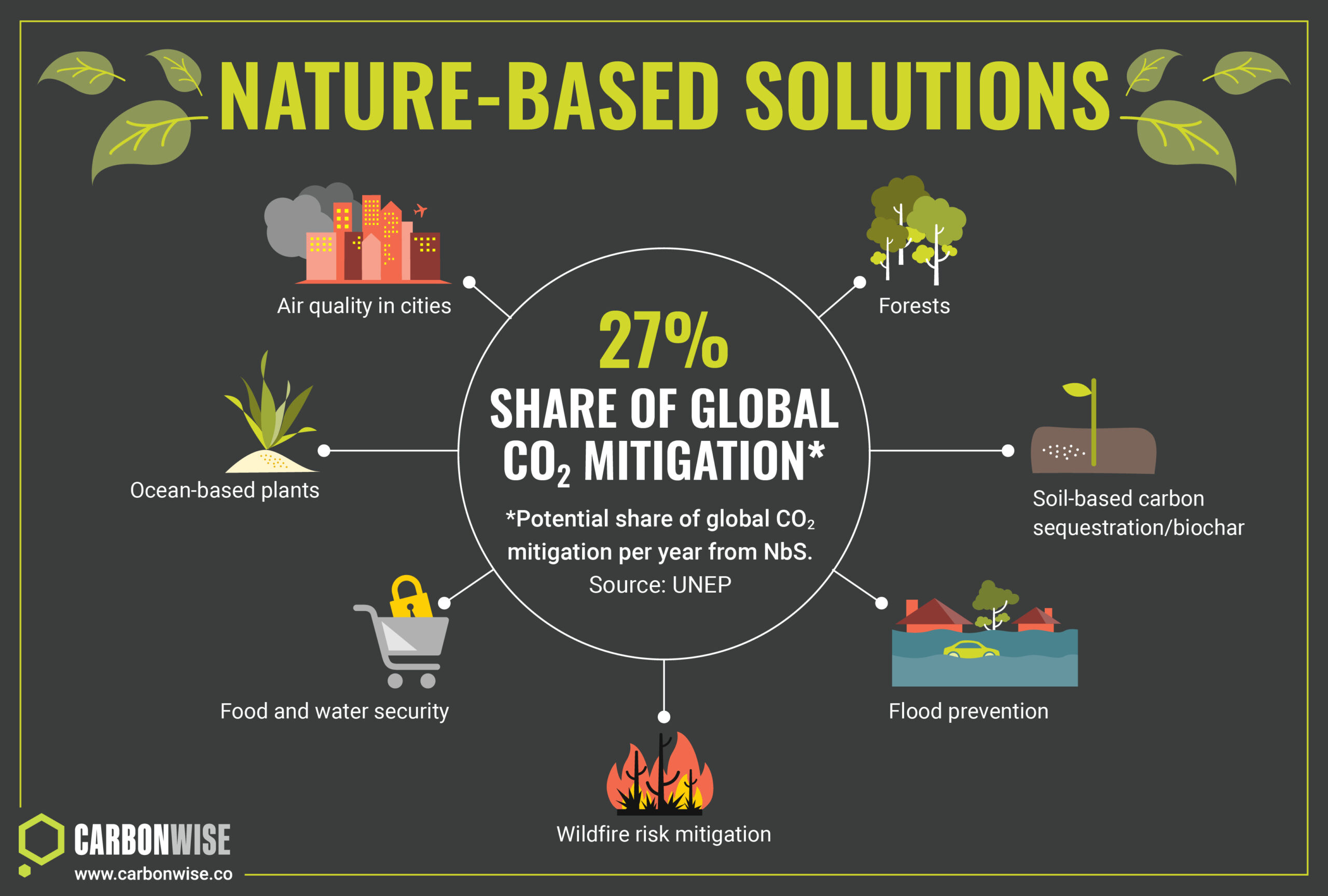The term ‘nature-based solutions’ encompasses a wide range of activities that aim to work with nature to resolve societal issues, ranging from climate change to coastal erosion, flooding, biodiversity loss and poor air quality in cities.
Other examples of nature-based solutions (sometimes abbreviated to ‘NbS’), include flood prevention, food and water security, wildfire risk mitigation and cooling in urban landscapes.
But in the context of climate change and carbon markets, nature-based solutions mainly relate to the use of natural systems to act as carbon ‘sinks’. These are projects that remove carbon dioxide (CO2) from the atmosphere, and as such they also come under the banner of ‘carbon removals’.
Since plants absorb CO2 directly from the atmosphere as they grow, they help to reduce the atmospheric concentration of the gas, and can therefore help to slow climate change.
For example, nature-based solutions include afforestation, (planting new forests in previously unforested land), reforestation (re-planting areas of deforested land), soil carbon sequestration projects such as the use of biochar, and blue carbon which refers to carbon removal projects in coastal and marine environments such as mangrove restoration and conservation projects and seagrass protection projects.
Why do nature-based solutions matter?
Nature-based solutions are an important tool in a wider suite of policies and approaches being deployed to help bring global greenhouse gas (GHG) emissions down to net zero by 2050. This is the target that science suggests will be necessary to avoid more severe climate change impacts.
While efforts are under way worldwide to reduce the output of GHGs such as CO2, it will also be necessary to remove it from the atmosphere to bring the concentration down to a level that will avoid destabilising the climate system.
According to the United Nations Environment Programme (UNEP), nature-based solutions projects of high quality and integrity could mitigate up to 10 gigatonnes (10 billion tonnes) of CO2 per year, corresponding to roughly 27% of current global annual emissions.
What are the benefits of nature-based solutions?
One of the major advantages of nature-based solutions is that in most cases they require no new technology: they represent a readily-available and proven way to remove atmospheric CO2 emissions at relatively low cost. They can also be deployed in a vast range of locations and at scale.
And in areas with regular rainfall and sufficient sunlight, nature-based solutions can be self-sustaining, so that once started, they can provide a carbon removal service with minimal intervention.
What are the drawbacks of nature-based solutions?
Nature-based solutions in themselves are not a perfect solution to the climate problem and cannot be a substitute for reducing emissions from energy, transport, industry and agriculture.
For a start, there is the question of permanence. Trees and other plants have a natural lifecycle, and since they give up their carbon after they die and break down, they are not a permanent store of CO2. However, they can still play a crucial role in storing carbon between now and 2050, when the bulk of action to limit emissions needs to take place.
Nature-based solutions also require land, and this can bring such projects into competition with other land-uses such as farming, agriculture, food crop cultivation, biofuels and others.
Finance is also an issue. The World Economic Forum has identified biodiversity loss and ecosystem collapse as among the top five global risks in the near-term, while UNEP estimates a financing gap of $700 billion per year to address these issues, suggesting much larger sums will be necessary to support nature-based solutions at the scale required.
What role do nature-based solutions play in carbon markets?
Carbon markets can play a role in supporting nature-based solutions.
This can be done either through the voluntary carbon market where companies pay for carbon to be reduced or sequestered on their behalf through projects such as forestry, or through the legally-binding compliance carbon markets where certain projects are deemed eligible for compliance with companies’ annual obligations to surrender carbon allowances or credits.
The option to allow nature-based solutions in carbon markets can boost demand for project-based credits in this sector and help to harness larger flows of finance to support and sustain more nature-based projects.
However, for nature-based solutions to work in an optimal way, they require standards that seek to ensure best practice in their design and implementation by project developers.
For example, the International Union for Conservation of Nature (IUCN) has developed the “IUCN Global Standard for Nature-based Solutions” which helps organisations to deploy effective projects by outlining key criteria and indicators that provide a benchmark of quality.
The IUCN estimates that one third of climate mitigation needed to meet the goals of the Paris Agreement can be provided by nature-based solutions, highlighting their crucial role in averting more serious and disruptive climate impacts.Nature-based solutions can therefore help absorb atmospheric CO2 on a timescale relevant to the global 2050 climate goal, while helping to shield populations and natural systems from extreme weather events. They can also deliver additional benefits such as preserving biodiversity, improving air quality, reducing floods and erosion and providing livelihoods for communities.






